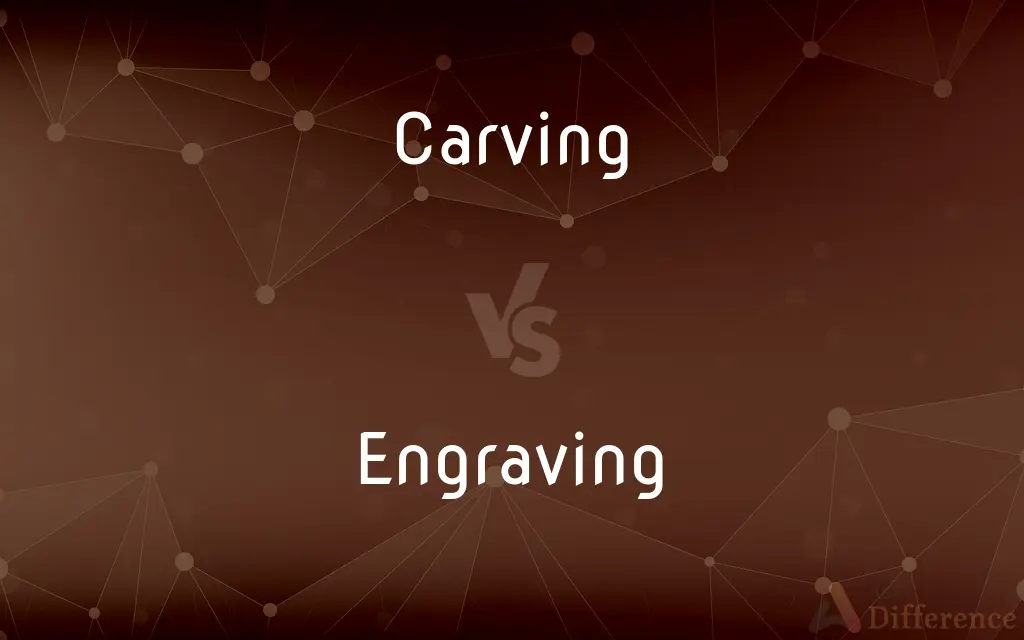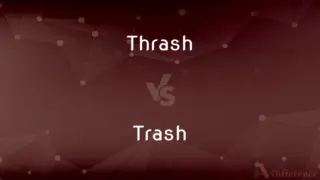Carving vs. Engraving — What's the Difference?
By Urooj Arif & Fiza Rafique — Updated on April 17, 2024
Carving involves shaping material by removing parts, often used for sculptures and reliefs; engraving is a technique of incising designs onto hard surfaces, primarily used for detailed artwork and printing.

Difference Between Carving and Engraving
Table of Contents
ADVERTISEMENT
Key Differences
Carving is a subtractive process where material is removed from a larger block, such as wood or stone, to create a three-dimensional object or sculpture. In contrast, engraving involves cutting or incising designs into a flat surface, often metal, to produce texts or images, especially for printing or decorative purposes.
While carving can be performed on a variety of materials including wood, stone, and ice, emphasizing the form and structure of the material, engraving is typically done on harder surfaces such as metals, glass, or stone, focusing on surface details and fine lines.
Carvers often use tools like chisels, gouges, and knives to remove material and shape their creation according to their vision. On the other hand, engravers use burins, drills, or lasers to create intricate patterns and designs that are often too small and detailed to be achieved through carving.
Carving usually results in standalone sculptures or three-dimensional reliefs that can be viewed from multiple angles, offering a physical presence in space. Conversely, engraving is often seen in fine art prints, personalized jewelry, or decorative elements on metal and glass, where detailed artwork can be appreciated up close.
The skills required for carving include an understanding of the material’s properties and a good sense of three-dimensional spatial awareness. Whereas, engraving requires precision and control to manage detailed and often delicate line work on tough surfaces.
ADVERTISEMENT
Comparison Chart
Technique
Subtractive removal of material
Incising designs into a surface
Materials
Wood, stone, ice
Metal, glass, stone
Tools
Chisels, gouges, knives
Burins, drills, lasers
Products
Sculptures, three-dimensional reliefs
Printed images, decorative designs
Detail
Can be detailed, focuses on 3D structure
Highly detailed, focuses on fine lines
Compare with Definitions
Carving
To shape by cutting into material.
He spent hours carving the wooden figure.
Engraving
To etch designs for decorative purposes.
She engraved the glass vase with elegant flowers.
Carving
To form by cutting parts of a whole.
The artisan carved the relief directly into the wall.
Engraving
To create artwork by etching into surfaces.
The printmaker engraved detailed scenes onto copper plates.
Carving
To produce designs by cutting into a surface.
She carved intricate patterns into the pumpkin.
Engraving
To incise a design onto a hard surface.
He engraved the watch with a personal message.
Carving
To make or shape by cutting.
They carved their initials into the tree's bark.
Engraving
To imprint by cutting or carving.
They engraved their wedding bands with their initials.
Carving
To create sculptures by removing material.
Artists carve stone into beautiful statues.
Engraving
To cut or carve in order to make prints.
The artist engraved the metal plate for printing.
Carving
Carving is the act of using tools to shape something from a material by scraping away portions of that material. The technique can be applied to any material that is solid enough to hold a form even when pieces have been removed from it, and yet soft enough for portions to be scraped away with available tools.
Engraving
Engraving is the practice of incising a design onto a hard, usually flat surface by cutting grooves into it with a burin. The result may be a decorated object in itself, as when silver, gold, steel, or glass are engraved, or may provide an intaglio printing plate, of copper or another metal, for printing images on paper as prints or illustrations; these images are also called "engravings".
Carving
The cutting of material such as stone or wood to form a figure or design.
Engraving
The art or technique of one that engraves.
Carving
A figure or design formed by this kind of cutting.
Engraving
A design or text engraved on a surface.
Carving
(sculpture) A carved object.
The carvings on the oak panels were ancient.
Engraving
An engraved surface for printing.
Carving
The act or craft of producing a carved object.
He took up carving after his retirement.
My father is an expert in carving, so we let him handle Christmas dinner.
Engraving
A print made from an engraved plate or block.
Carving
Present participle of carve
Engraving
(art) The practice of incising a design onto a hard, flat surface, by cutting grooves into it.
Carving
(snowboarding) Executing turns without pivoting.
Engraving
(printing) The art of producing an image from an engraved printing form, typically made of copper.
Carving
The act or art of one who carves.
Engraving
(countable) A print produced from an engraving.
Carving
A piece of decorative work cut in stone, wood, or other material.
Engraving
(music) The art of drawing music notation at high quality, particularly on a computer.
Carving
The whole body of decorative sculpture of any kind or epoch, or in any material; as, the Italian carving of the 15th century.
Engraving
Present participle of engrave
Carving
A sculpture created by carving (as wood or ivory or stone)
Engraving
The act or art of producing upon hard material incised or raised patterns, characters, lines, and the like; especially, the art of producing such lines, etc., in the surface of metal plates or blocks of wood. Engraving is used for the decoration of the surface itself; also, for producing an original, from which a pattern or design may be printed on paper.
Carving
Cutting away parts to create a desired shape
Engraving
That which is engraved; an engraved plate.
Carving
Creating figures or designs in three dimensions
Engraving
An impression from an engraved plate, block of wood, or other material; a print.
Engraving
A print made from an engraving
Engraving
A block or plate that has been engraved
Engraving
Making engraved or etched plates and printing designs from them
Common Curiosities
How does engraving differ from etching?
Engraving involves physically carving into the material, while etching uses chemical processes to create designs.
Can carving be automated?
Yes, carving can be automated using CNC machines which replicate designs in various materials.
What materials are commonly used in carving?
Common materials include wood, stone, and ice.
Can both carving and engraving be considered forms of art?
Yes, both are highly respected forms of visual art, each requiring specific skills and techniques.
How precise is engraving compared to carving?
Engraving allows for finer, more precise detail, especially useful in printmaking and jewelry.
What types of products are commonly carved?
Products include sculptures, decorative reliefs, and furniture.
How does the choice of material affect the outcome in carving and engraving?
In carving, the type of material affects the ease of removal and the final appearance, with softer materials like wood being easier to shape than harder ones like marble. In engraving, material choice affects the tooling and the level of detail possible, with harder materials allowing for finer, more durable lines.
Is engraving limited to artistic applications?
No, engraving is also widely used in industrial applications, such as creating serial numbers on tools and parts, and in fashion, for customizing accessories and jewelry.
What are the traditional tools for carving?
Traditional tools include chisels, knives, and gouges.
What is the main purpose of engraving?
The main purposes include creating art for prints, personalizing items, and decorative detailing.
Are there modern techniques for engraving?
Modern techniques include laser engraving, which uses lasers to achieve high precision and detail.
What safety considerations should be kept in mind when carving or engraving?
Safety in both carving and engraving involves proper handling of tools and materials. Protective eyewear is essential to guard against flying debris in carving and fine particles in engraving. Additionally, ensuring that tools are kept sharp and handled correctly minimizes the risk of accidents.
Can both carving and engraving be done by machines?
Yes, both processes can be automated. CNC (Computer Numerical Control) machines can carve intricate designs into wood, stone, and other materials, while laser engravers can etch extremely detailed patterns onto metals, glass, and other hard surfaces.
What is the typical learning curve for mastering carving vs. engraving?
Mastering carving generally involves learning to handle three-dimensional perspectives and the physical properties of various materials, which can be quite challenging and time-consuming. Engraving requires precision and control over fine details, demanding steady hands and patience, with a potentially steep learning curve depending on the complexity of the designs.
Share Your Discovery

Previous Comparison
Curt vs. Kurt
Next Comparison
Thrash vs. TrashAuthor Spotlight
Written by
Urooj ArifUrooj is a skilled content writer at Ask Difference, known for her exceptional ability to simplify complex topics into engaging and informative content. With a passion for research and a flair for clear, concise writing, she consistently delivers articles that resonate with our diverse audience.
Co-written by
Fiza RafiqueFiza Rafique is a skilled content writer at AskDifference.com, where she meticulously refines and enhances written pieces. Drawing from her vast editorial expertise, Fiza ensures clarity, accuracy, and precision in every article. Passionate about language, she continually seeks to elevate the quality of content for readers worldwide.













































